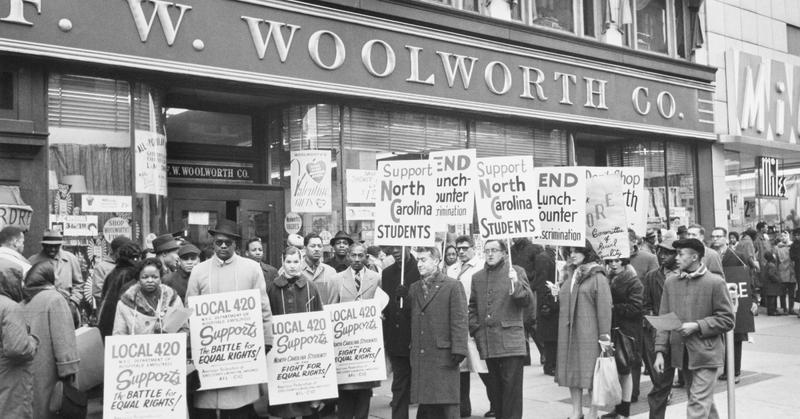The Very First Sit-In At A Greensboro Woolworth's, 1960 (Photos)
By | March 18, 2019

On February 1, 1960, the first "sit-in" took place in Greensboro, North Carolina, and this demonstration by four courageous young African-American men proved a pivotal moment in the Civil Rights Movement. The "Greensboro Four," all students at the nearby North Carolina Agricultural and Technical College, sat down at the lunch counter at the Woolworth’s store in Greensboro -- and as expected, they were not served. In fact, they were told to leave because the lunch counter refused to serve blacks. The Greensboro Four touched off a series of sit-ins and non-violent protests that helped to eliminate segregation policies ahead of the Civil Rights Act. Let’s look at some rare photos from the Greensboro Woolworth Sit-In that started it all.
The Students Were Protesting Segregation

In the Jim Crow South in the 1960s, laws were still being enforced that allowed businesses to refuse to serve African-Americans. And if they did, it was often in specially-designated areas that kept them away from their white customers. As a nationwide company, Woolworth's had a policy that prohibited African Americans from sitting at the lunch counter.
The Greensboro Four Planned A Peaceful Protest

The Greensboro Four—David Richmond, Ezell Blair, Joseph McNeil, and Franklin McCain—were inspired by the non-violent protests of Mohandas Gandhi. They were also influenced by CORE and their Freedom Riders. CORE, the Congress for Racial Equality, was founded in 1942 in Chicago as an organization dedicated to bringing about equality for all people, regardless of race or other factors. At the time of CORE’s founding, Gandhi was in the midst of his highly-publicized non-violent protests over British occupation of India. The CORE founding members believed that the same principles could be applied to the Civil Rights Movement.
The Murder Of Emmitt Till Also Sparked The Sit-In

The Greensboro Four also stated that they were moved to action by the injustice of the murder of Emmitt Till five years earlier. Till, just a 14 year old boy, was brutally beaten and lynched by white townsfolk in Mississippi because he allegedly whistled at a white woman. All of the accusers were acquitted of the crime, a move that created outrage across the country.
Sitting For What They Stood For

The Greensboro Four approached the Woolworth’s lunch counter and sat down. That was it. When asked to leave, the students refused. They continued to sit at the counter. A white businessman in Greensboro who was sympathetic to the cause, Ralph Johns, alerted the newspapers to the non-violent protest. Reporters flooded the store to capture the event.
Store Employees Called The Police

When police arrived on the scene of the Woolworth’s sit-in, they found four polite, well-dressed, respectful young men who refused to give up their seats. The students had behaved peacefully and there was no provocation so the police had no grounds for arresting them. The Greensboro Four remained in their seats at the lunch counter until the store closed. The next morning, they were back in their seats.
Other College Students Joined The Sit-In

As the sit-in stretched in to multiple days, the Greensboro Four were joined by other college students. They not only halted the business to Woolworth’s but to other surrounding businesses as well. Television coverage of the non-violent sit-in was broadcast all over the country.
Sit-Ins Spread Throughout The Country

College students across the country, in a show of solidarity toward the Greensboro Four, began their own non-violent sit-ins at lunch counters all over the South. From there, the sit-in movement expanded beyond lunch counters to hotels, beaches, libraries, and other businesses that made a practice of segregating black and white customers.
Sit-Ins in 55 Cities

In just two months' time, the Greensboro sit-in inspired hundreds of other sit-ins in 55 cities across 13 states, mostly in the South. Some of these events were not as peaceful as the Greensboro protest. Police arrested some of the students involved in those sit-ins for trespassing or disturbing the peace. Still, the movement and its commitment to non-violence got the attention of the world and helped to shed a spotlight on the injustices of the Jim Crow Laws in the South.
The Student Nonviolent Coordinating Committee

In response to the sit-in movement, the Student Nonviolent Coordinating Committee formed. This group was instrumental in many of the other key events of the Civil Rights Movement, including the March on Washington. They worked with other groups to push through the passage of the Civil Rights Act of 1964.
The Lunch Counter Is Now A Museum

Today, the former Woolworth's in Greensboro is no longer a store and lunch counter. It is now home to the International Civil Rights Center and Museum, which features a restored version of the lunch counter where the Greensboro Four sat. As for the original counter itself, it has been donated to the Smithsonian National Museum of American History in Washington, D.C.
